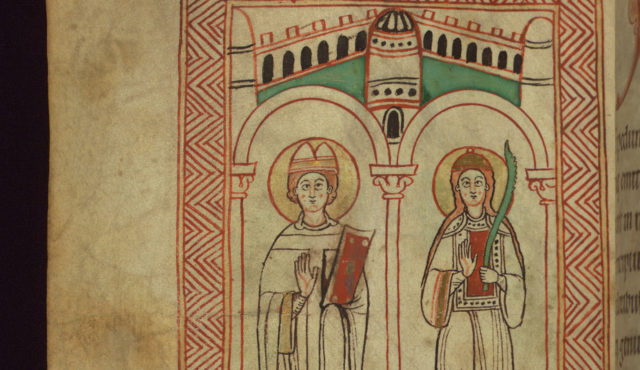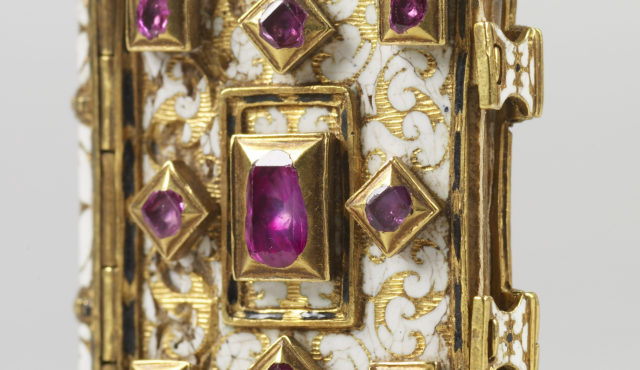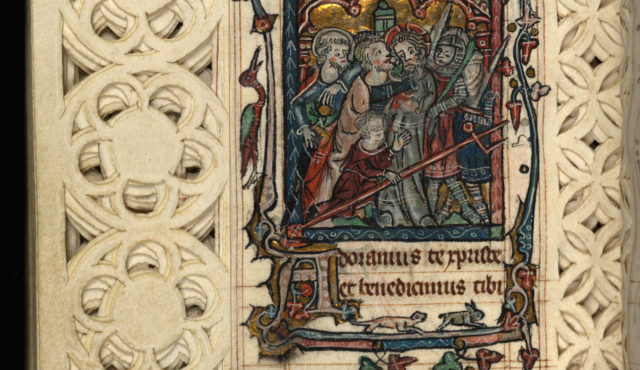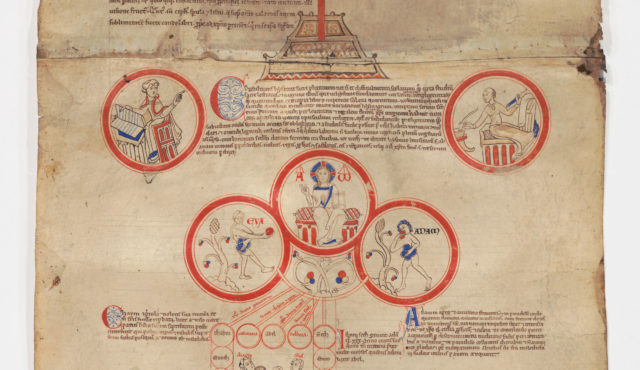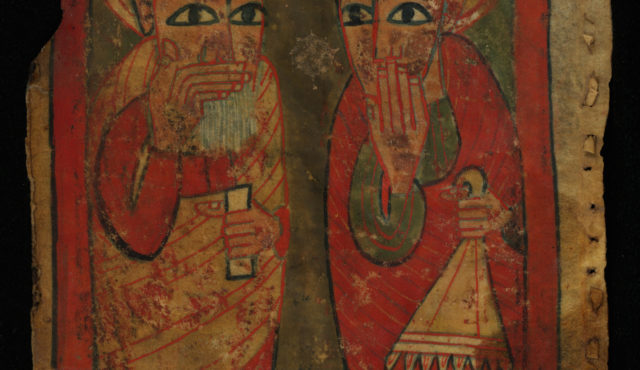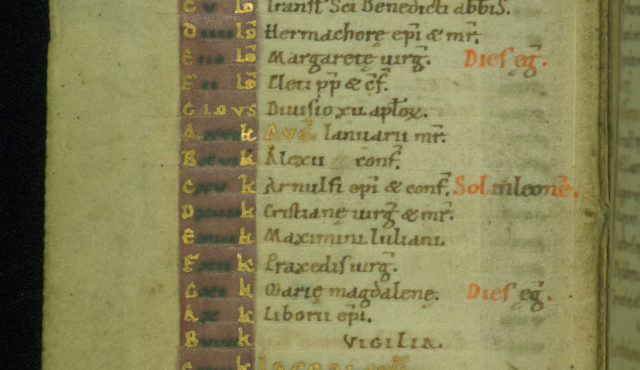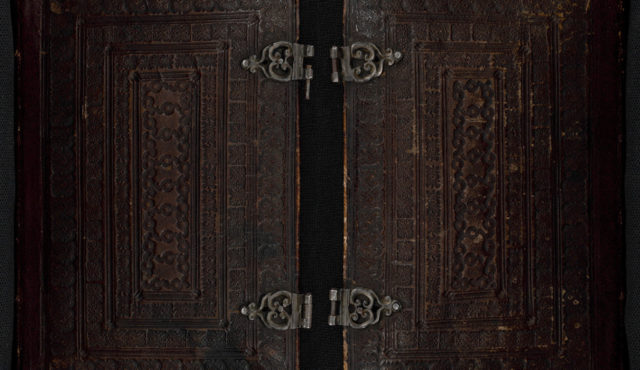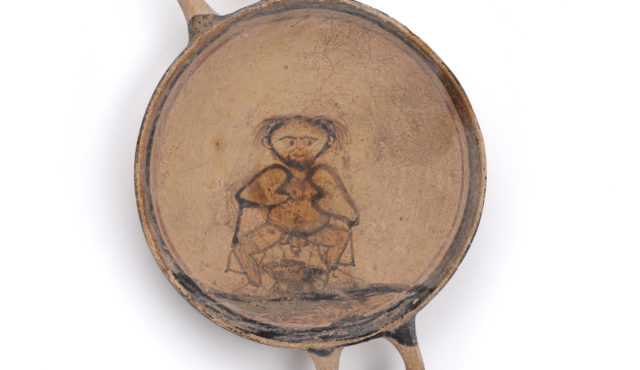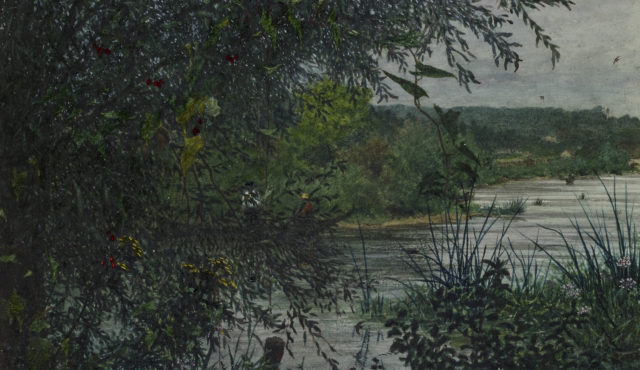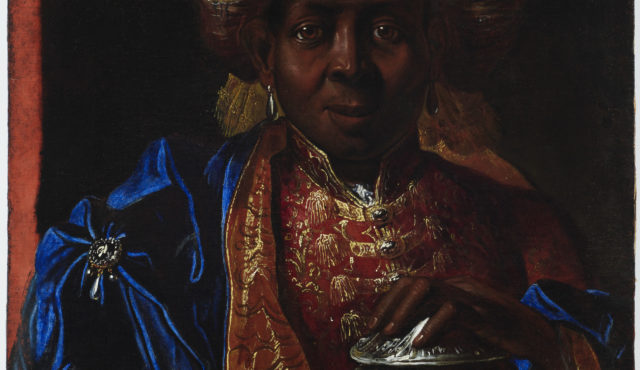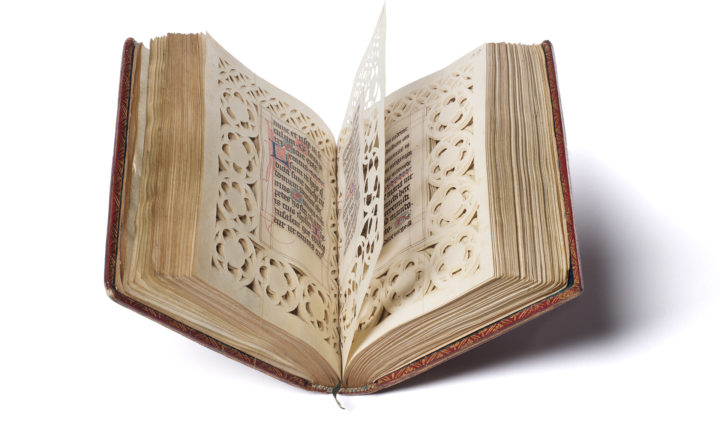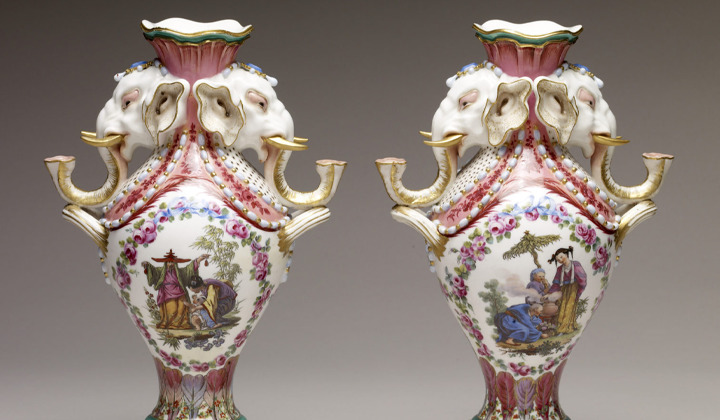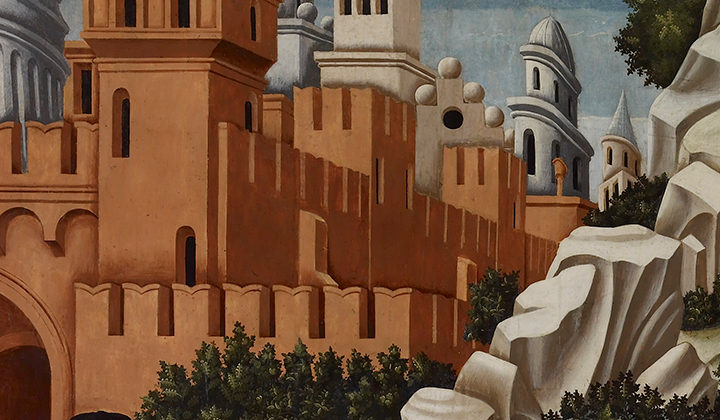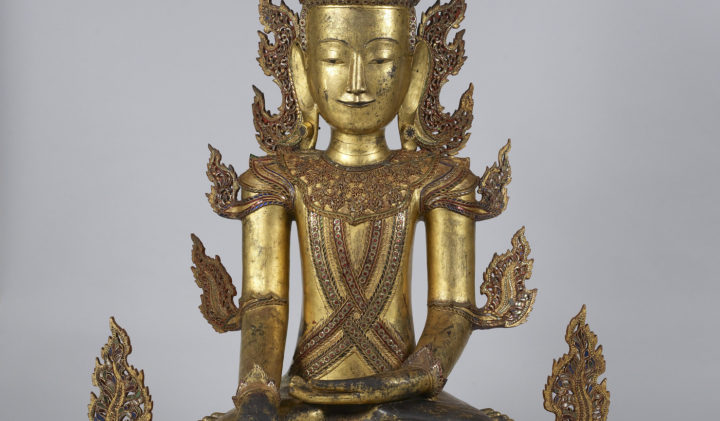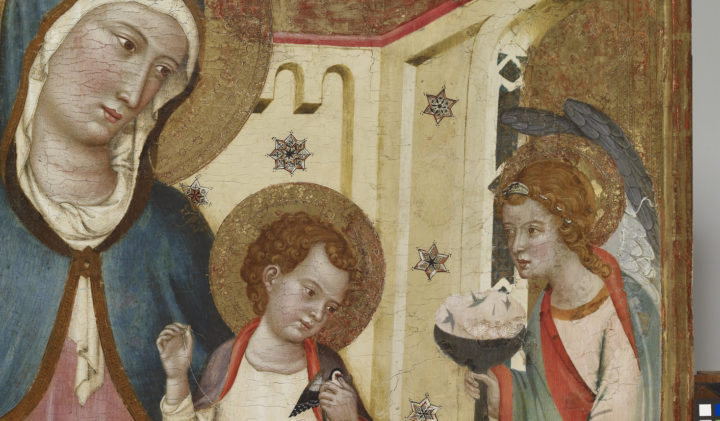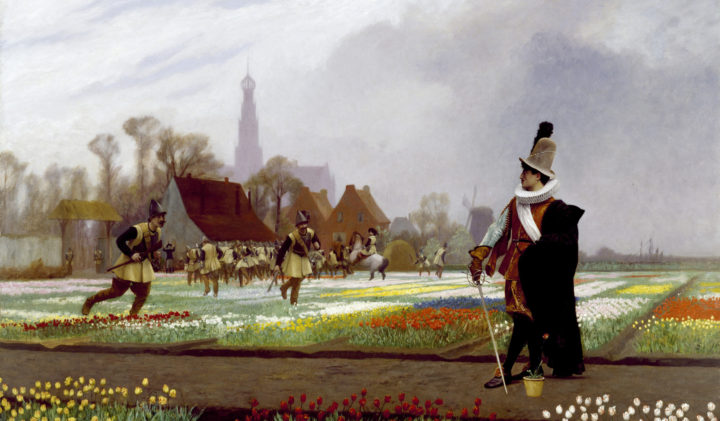Black manuscripts, written and illuminated on parchment that has been stained, present a figure-ground reversal so that the images and texts seem to step out of darkness. Whereas medieval scribes and illuminators normally began with a luminescent creamy off-white parchment substrate and applied ink and pigments, thereby conceptualizing the image as dark-on-light, makers of these manuscripts began with a dark, opaque substrate and built up light and bright colors, thereby conceptualizing the image and script as light-on-dark. Black Books of Hours were produced from ca. 1458 to ca. 1485 for the Burgundian nobility, whose bibliophiles appreciated their exquisite craftsmanship and unusual technique. In three of the most celebrated surviving examples—two Books of Hours now in Vienna[1] and one in New York[2]—the reversed figure-ground painting is executed in a jolting palette, including a shade of lime green that seems to phosphoresce.[3] Black parchment must have appealed to those with a sense for elegance and for unusual objects, and perhaps those who knew about purple-dyed parchment used in the most luxurious manuscripts from an earlier era, such as the Codex Argenteus, a sixth-century manuscript written in silver and gold on prepared purple parchment (now in the Uppsala University Library, acc. no. DG 1). A purple-stained (or black-stained) manuscript would be notably unusual and special, even from a distance.
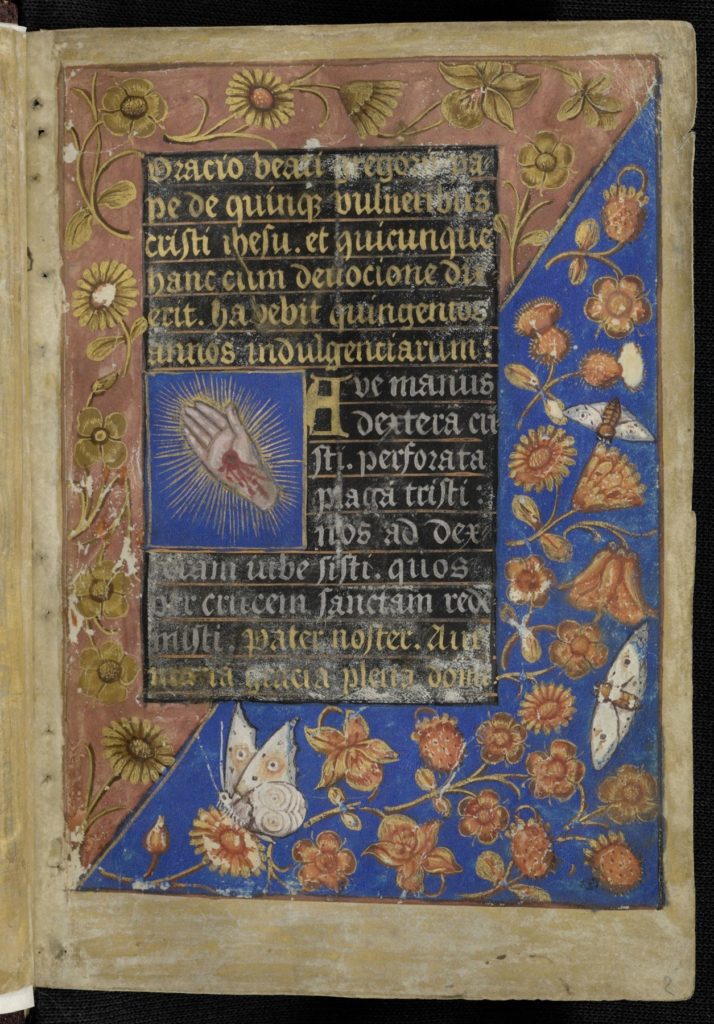
The Masters of the Dark Eyes, Prayer book (Solvay 7), Netherlands (Utrecht?)?, ca. 1510, ink and pigment on parchment. Royal Library of Belgium (KBR), Brussels, bequest of Madame Louis Solvay, 1962, acc. no. Solvay FS IX 7A, fol. 2r
While Marie Hartmann is currently studying Burgundian black Books of Hours in their courtly and material contexts,[4] the subject of the current essay is more narrow and treats a relatively unknown black manuscript now in the Brussels Royal Library (KBR) under the shelf number Solvay FS IX 7A (hereafter “Solvay 7”; fig. 1). In this essay I will describe the manuscript and its recent history, and then speculate on its possible audience, and—as far as is possible without a technical examination[5]—its mode of production. To do this, I will present an overview of its contents, and then situate its script and imagery by comparing it to related examples, including a missal at the Walters (acc. no. W.175). Solvay 7 was produced two decades later than the Burgundian black Books of Hours, was probably not made in a courtly ambit, and departs from the other black manuscripts in its representational strategies. It could be described as a later imitation. I will argue that, because of the division of labor in the manuscript’s production, its script has a different relationship to tradition and innovation than does its imagery.
Before entering the Royal Library of Belgium (KBR), the manuscript was owned by Madame Louis Solvay (née Odilie Fontaine, 1877–1962), who amassed a considerable collection of printed books and a small collection of manuscripts. Previously, the manuscript had been owned by Lucien Graux (1878–1944), an inventor, doctor, book collector, perfumer, and resistance fighter in World War 2 who died at Dachau in 1944. His widow sold his collections in a series of sales in Paris in the late 1950s. Madame Solvay bought it in the sale of January 26, 1957, near the end of her life. She bequeathed her books upon her death in 1962 to the Bibliothèque royale de Belgique, where the Solvay gift is housed in the department of rare books and designated as Fonds Spécial IX.[6] A catalogue of her bequest was drawn up shortly after it entered the Royal Library.[7]
The 1965 Solvay catalogue lists it as a Flemish Book of Hours; however, the manuscript does not contain any of the defining texts of a Book of Hours, and it should be called a prayer book instead. The contents are described in an appendix below. Furthermore, whether it is in fact Flemish is debatable; it may have been made in the Northern Netherlands, possibly in Utrecht or in South Holland, as I will discuss. In its fragmented state, the manuscript contains only twenty-one thick leaves, bound out of order and mis-foliated.
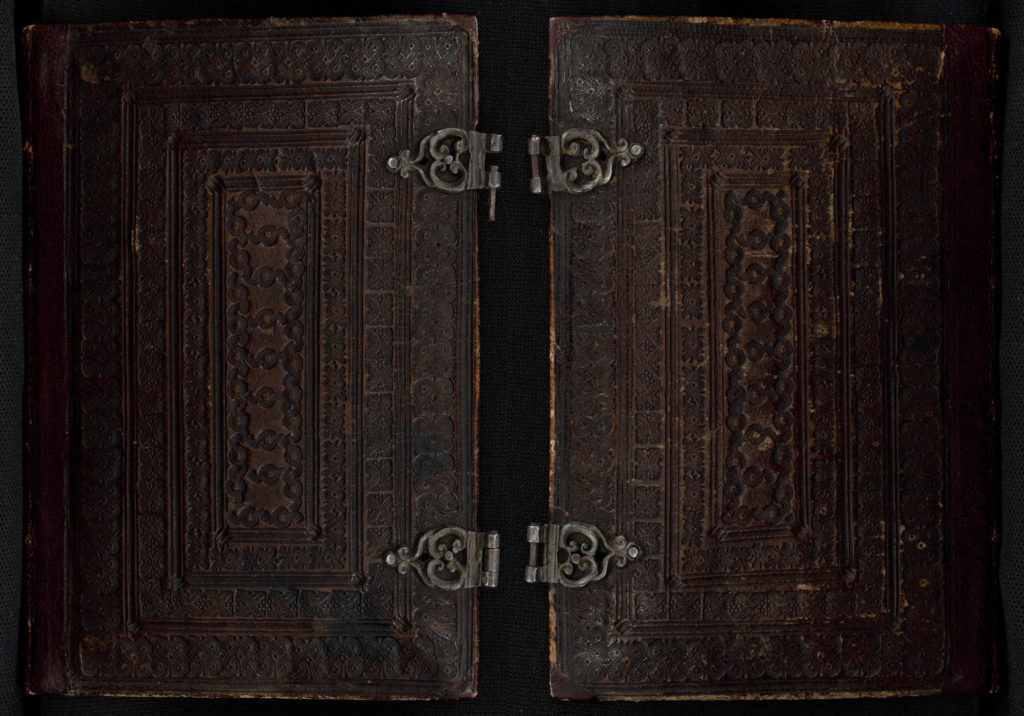
Binding, Prayer book (Solway 7), KBR, acc. no. Solvay 7 FS IX 7A
Someone in the nineteenth or twentieth century, possibly the person who sold the manuscript to Lucien Graux, gathered the remaining folios of the black prayerbook, attached the singletons to stubs, and assembled the surviving parts into a late medieval binding. The binding, which was probably made in Spain or Italy in the late fifteenth or sixteenth century, consists of brown leather that has been stamped with tendrils and then stretched over boards, which protect the book and make it rigid (fig. 2). In other words, the binding was taken off a different manuscript and then applied to the 21 tattered remaining folios of this one. The spectacular (although inappropriate) binding was probably calculated to appeal to a modern collector who was more interested in unusual objects than complete or authentic ones.
Its most startling feature is that black paint in the text block, and gold paint in the borders, provides a base layer. Whereas most medieval manuscripts have script and decoration on a base of parchment, here no naked parchment is visible: the painted parchment extends to the edges relentlessly, and solid fields of black and gold form the backgrounds for the letters and decorative motifs, respectively. That this dazzling and unusual book remained in private ownership until 1962, was miscatalogued, and was published without photographic reproductions account for its omission from the relevant scholarly literature.[8]
The Contents of Solvay 7
The manuscript, which is missing an indeterminable number of folios, formed part of a larger volume, but no detached folios have come to light. As is clear from the contents listed in the appendix, the manuscript has been thoroughly cut apart. Many surviving leaves, formerly part of bifolios, are now singletons. This means that any collation diagram is speculative. Furthermore, it is difficult to ascertain its original magnitude or to gauge how lavishly decorated it was, since its most exquisitely decorated pages would have been the first targeted by souvenir collectors. Whoever cut up the book probably sold these, to be mounted or framed separately. Another indication that the manuscript was rife with images is that prayers within Solvay 7 emphasize piety that relies on, and accompanies (or accompanied), images. It opens with the Salve sancta facies (Hail, holy face) that is missing its image of the Face of Christ (fig. 3). The prayer addresses the image that appeared on Veronica’s veil when she used it to wipe Christ’s face as he carried his cross to Calvary. Because the prayer addresses the image, it is often illustrated with either a tightly-cropped image of Christ’s face, or one showing Veronica brandishing her miraculous veil.[9] This leaf now forms a singleton and is attached to the binding by a tab, indicating that its position is not organic but has been disrupted.

Salve sancta facies, Prayer book (Solway 7), KBR, acc. no. Solvay 7 FS IX 7A, fol. 1r
The next text (figs. 1, 4) presents a prayer to the Five Wounds of Christ. The scribe has left gaps for five small images depicting the fragmented wounds.[10] The pierced wounds provide the framework for the popular prayer to the wounds, beginning Ave dextera manus cristi / perforata manu tristi. / Nos ad dexteram manum fisti. / Quo per dexteram redemisti. That they rhyme strongly suggests that supplicants read these prayers aloud, for only when vocalized do the rhyming metrical stanzas reach their fullest form. The scribe has used punctuation—periods or colons—to mark the ends of the lines, thereby emphasizing their rhyming, metrical qualities. The prayer to the Wounds of Christ had features that votaries desired: it rhymed, it earned time off purgatory, and it demanded contemplating oddly compelling images. The spokes of radiance around the pierced and disembodied extremities of Christ, and his heart, gave the painters an opportunity to add ample gold.
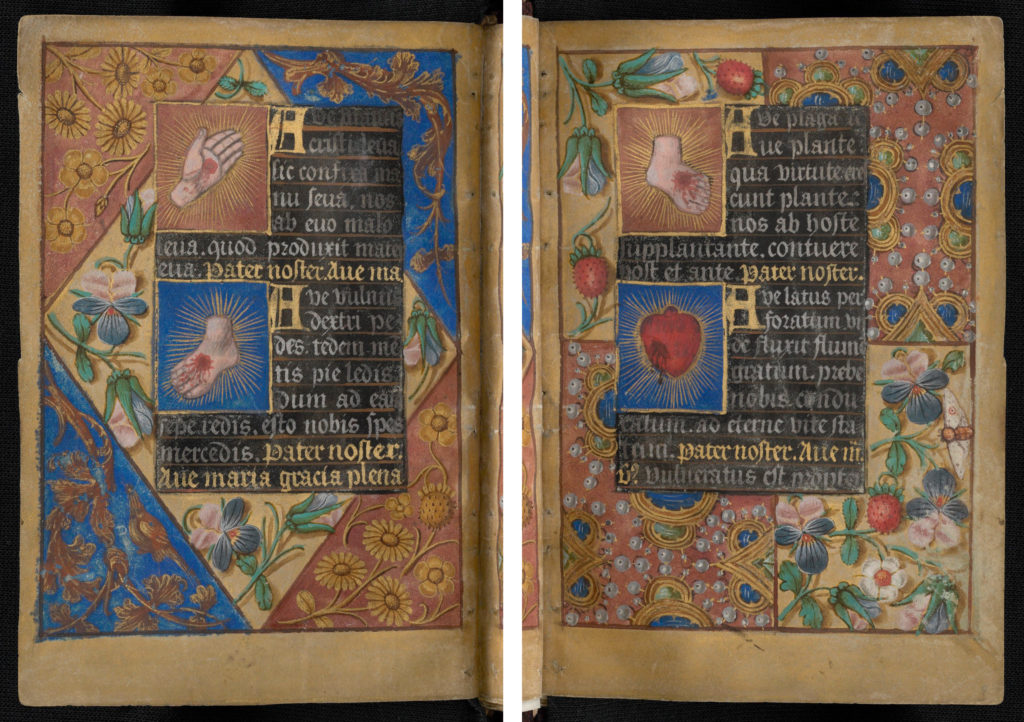
Opening with a prayer to the Wounds of Christ, Prayer book (Solway 7), KBR, acc. no. Solvay 7 FS IX 7A, fols. 2v‒3r
The prayer to the Name of Christ accompanies an unexpected miniature (figs. 13, 5), one depicting Christ as Salvator Mundi (Savior of the World) bearing the crown of thorns, making the sign of benediction and holding an orb. Clearly, the illuminators had many model sheets at their disposal as they deployed a wide range of images throughout their oeuvre. That the prayer ends in medias res again points to a missing folio; that folio may have had an image of the Trinity to preface the next prayer, which addresses the Trinity and begins on fol. 5r (fig. 5).
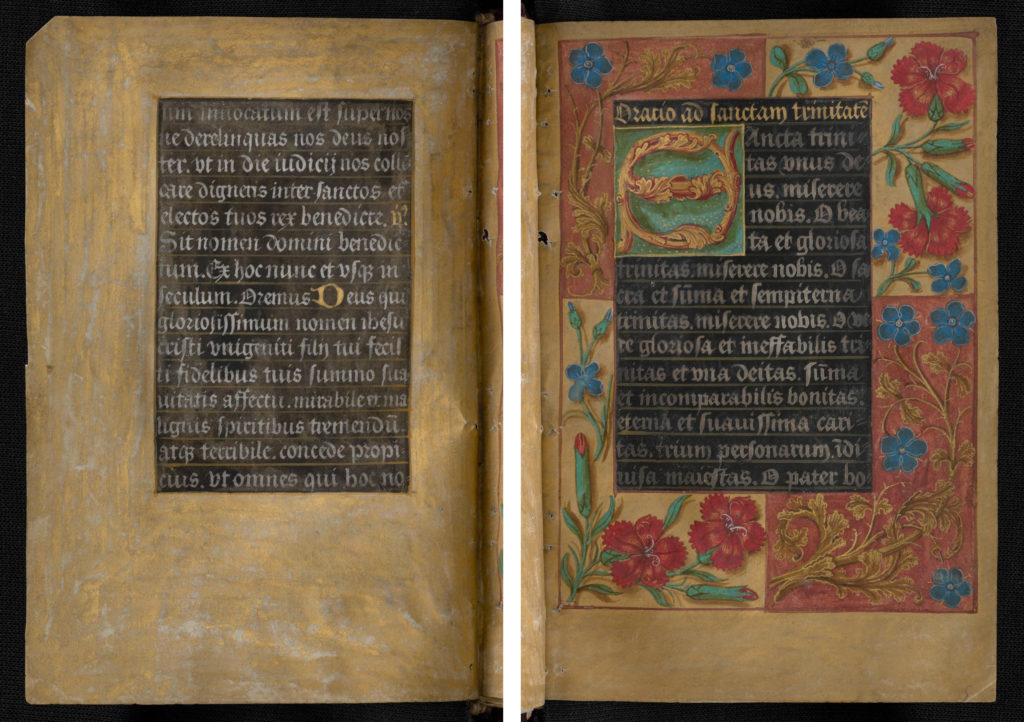
Non-organic opening, with the beginning of a prayer to the Trinity, Prayer book (Solway 7), KBR, acc. no. Solvay 7 FS IX 7A, fols. 4v‒5r
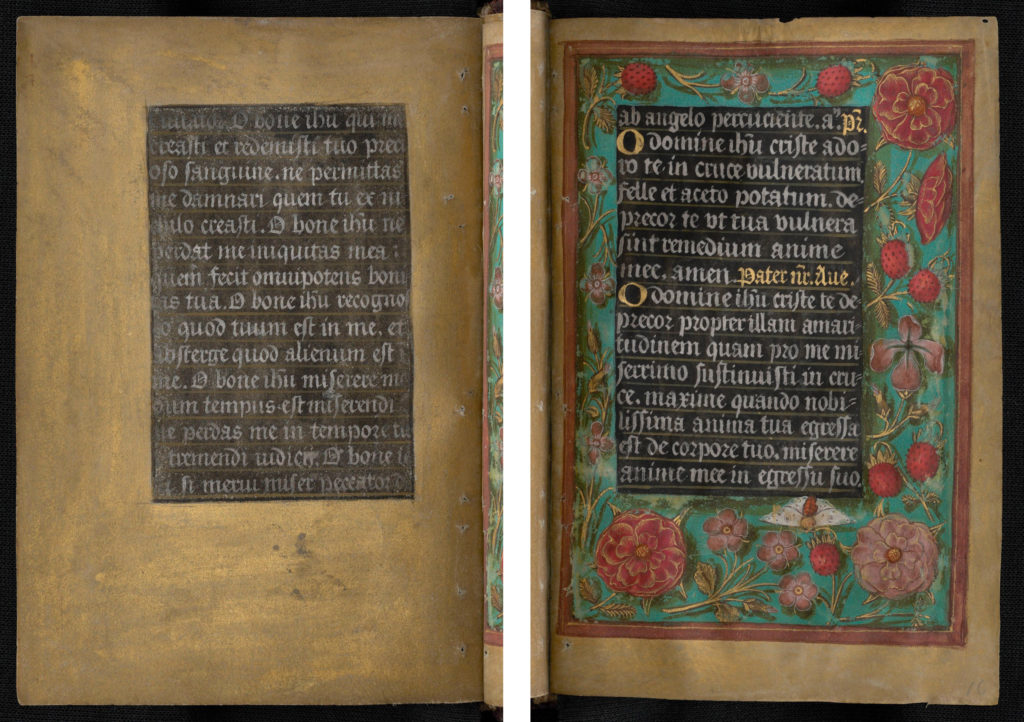
Non-organic opening, with the middle of Verses of St. Gregory (on the recto), Prayer book (Solway 7), KBR, acc. no. Solvay 7 FS IX 7A, fols. 15v‒16r
The volume also contains other prayers dedicated to Christ, which may have originally been grouped together. One of these is the Verses of St. Gregory, which begins on fols. 16r–16v, and continues on fol. 6r (figs. 6, 7). That the beginning is missing suggests once again that a folio—one containing a partial-page image and the incipit of the text—was cut out of the manuscript. The most likely subject of this image would have been the Mass of St. Gregory, in which the suffering Christ appears in the host as Gregory elevates it during Mass. This prayer often had a rubric indicating that an enormous indulgence was available to those who read the prayer in front of the relevant image, with pious intentions.[11] Each of the verses of St Gregory begins with an O, the onomatopoeic sound of lament, and the group ends with a version of a prayer known as the Obsecro te (I beseech thee). This is usually a prayer to Mary but here has been reworked to fit a context of Christ’s suffering (fig. 7). The illuminators have enhanced it by providing full flower borders around both text blocks where the prayer appears.
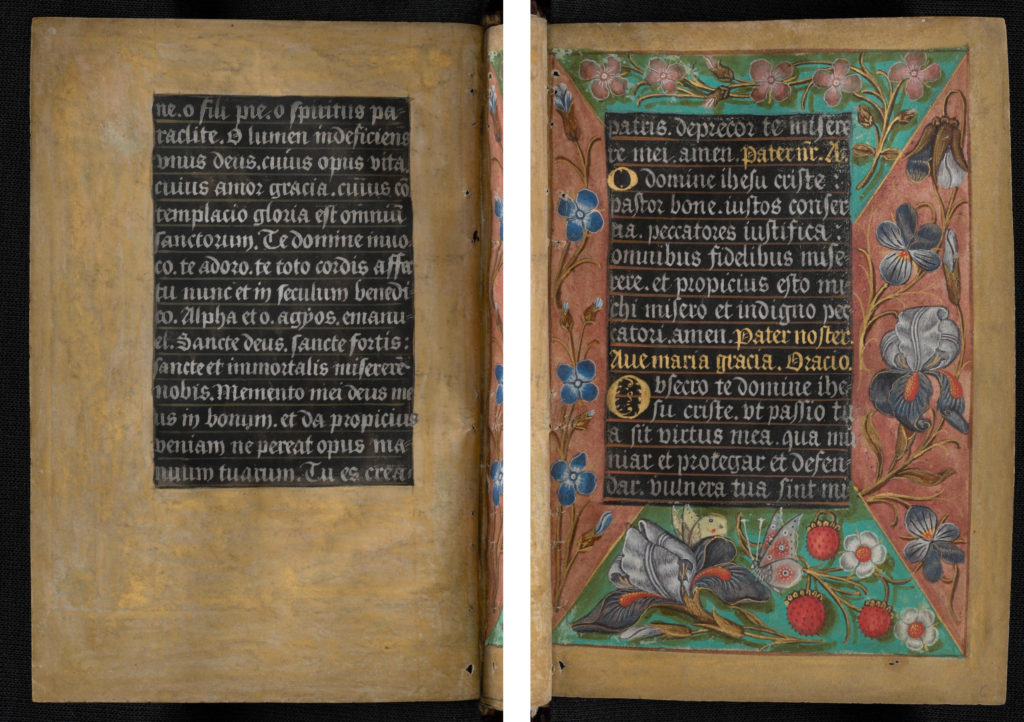
Non-organic opening, with the end of Verses of St Gregory (on the recto), Prayer book (Solway 7), KBR, acc. no. Solvay 7 FS IX 7A, fols. 5v‒6r
Another group of prayers honors single saints, beginning with St. Anne. Here the illuminators present a different kind of border: a skeuomorph of silver script on purple-stained parchment (fig. 8).[12] The ornate text in the frame are written in Roman capital letters in a lapidary style (lapis means stone, and this script style resembles antique inscriptions in stone slabs). The words in the border spell out part of a rhyming suffrage to St. Anne; however, the beginning of the suffrage is missing, which suggests that the folio originally facing fol. 8r had a comparable text-frame brandishing the beginning of the suffrage. It is reasonable to assume that this now-missing folio held an image depicting St. Anne.
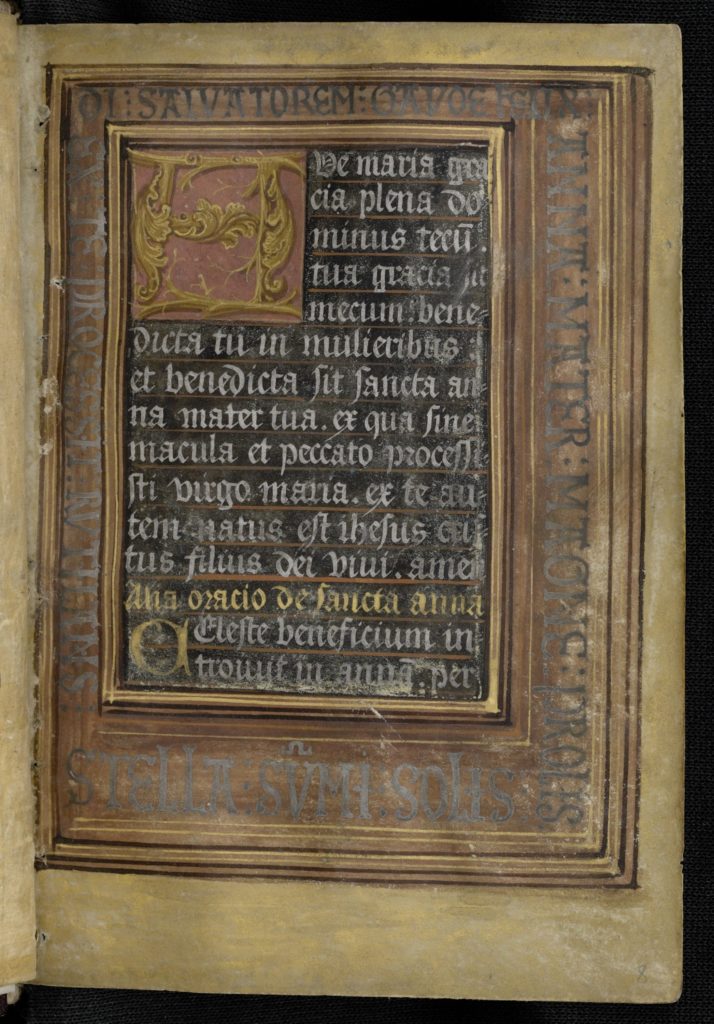
Prayer to St. Anne, Prayer book (Solway 7), KBR, acc. no. Solvay 7 FS IX 7A, fol. 8r
By inscribing Roman capitals on a purplish-brown background in the border, the illuminators may be signaling the origins of the technique of writing in silver (or argyrography, from the Latin word for silver, argentum). Scribes in Late Antiquity wrote luxury manuscripts with this technique by applying silver letters to parchment stained purple. The purple color was made from dyestuff harvested from the murex, a rare sea snail. The resulting dye was so expensive that it was only accessible to royalty. The makers of the Solvay 7 manuscript produced an imitation of this luxury technique, made with much cheaper materials. Although determining the precise materials they used awaits laboratory investigation, they clearly did not stain the pages with costly murex but rather brushed it with purple-brown paint, and the “silver” ink they employed may contain little if any silver. Pigments such as lead white or zinc oxide were not only cheaper than silver but also would not tarnish.
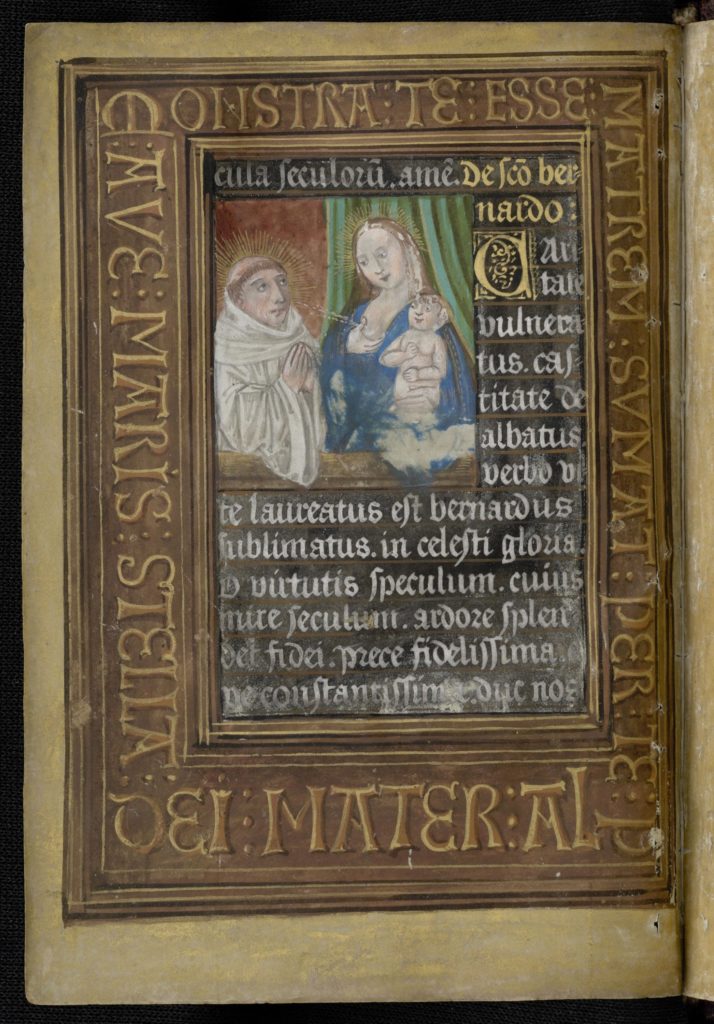
Prayer to St. Bernard, Prayer book (Solway 7), KBR, acc. no. Solvay 7 FS IX 7A, fol. 11v
The illuminators have used a similar approach to frame the opening folio of a prayer to St. Bernard, which begins with an eight-line miniature depicting the Lactation of St. Bernard (fig. 9). The painters have written out two lines from the prayer Ave, maris stella (Hail, star of the sea…), which includes a phrase purportedly uttered by St. Bernard (“Show thyself to be a mother”). Mary, when challenged with this request, answered by squirting breast milk into Bernard’s mouth, which is the event depicted in the small miniature. In this border design, the illuminators have used “gold” instead of “silver” script in the word-frame but have retained the same Roman capital letterforms, rendered as if they had been carved into stone. As some Netherlandish panel painters had also discovered, these illuminators could make a more convincing illusion of gold when they did not employ gold paint at all.[13] Instead, a stroke of light-yellow paint next to a stroke of warm brown would offer a convincing illusion of light playing on a gold surface. Such a technique offers a fictive recession into depth, as opposed to a layer of actual gold, which clings to the surface of the canvas or parchment and prevents a viewer from perceiving a three-dimensional golden object. The illuminator who inscribed the words into the border was not the same person as the scribe who wrote the words into the text block. The former was a painter using a brush, and the latter a scribe using a pen. The former built letters out of two colors to create a three-dimensional effect, and the latter applied only a single color at a time and achieved a flat effect.
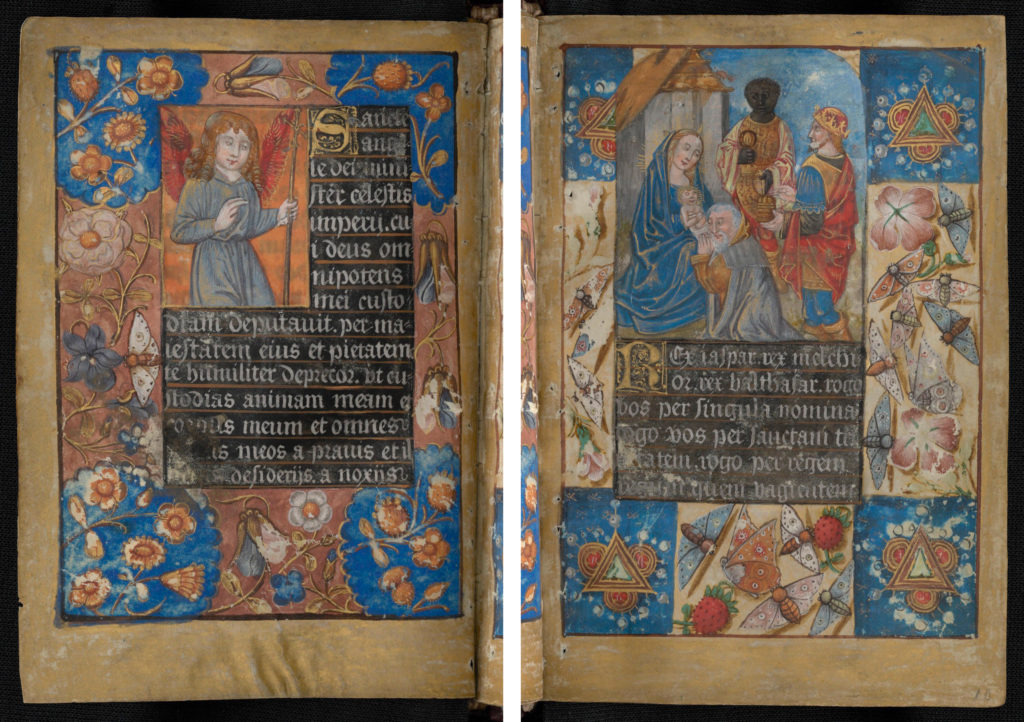
Non-organic opening, with a prayer to the Guardian angel, and a prayer to the Three Magi, Prayer book (Solway 7), KBR, acc. no. Solvay 7 FS IX 7A, fols. 9v‒10r
The prayer book includes suffrages to one’s guardian angel (fols. 9r–9v and 7r–7v) and to the Magi (fols. 10r–11v), with a column-wide miniature depicting the three Magi presenting gifts to the Christ Child (fig. 10). Misbinding has generated their current positions, facing each other. Among the surviving suffrages—those dedicated to Saints Catherine, Barbara, and Anthony—only the latest is represented by an organic two-page spread (fig. 11). From this one can see that the artists treated—in the hierarchy of decoration—small miniatures to a fully painted border, but that text pages had plain borders. “Plain” means painted fully with an opaque gold ground. It is as if the artists, in preparing a border for a flower-strewn background, realized that the expanse of gold was both visually interesting and sumptuous.
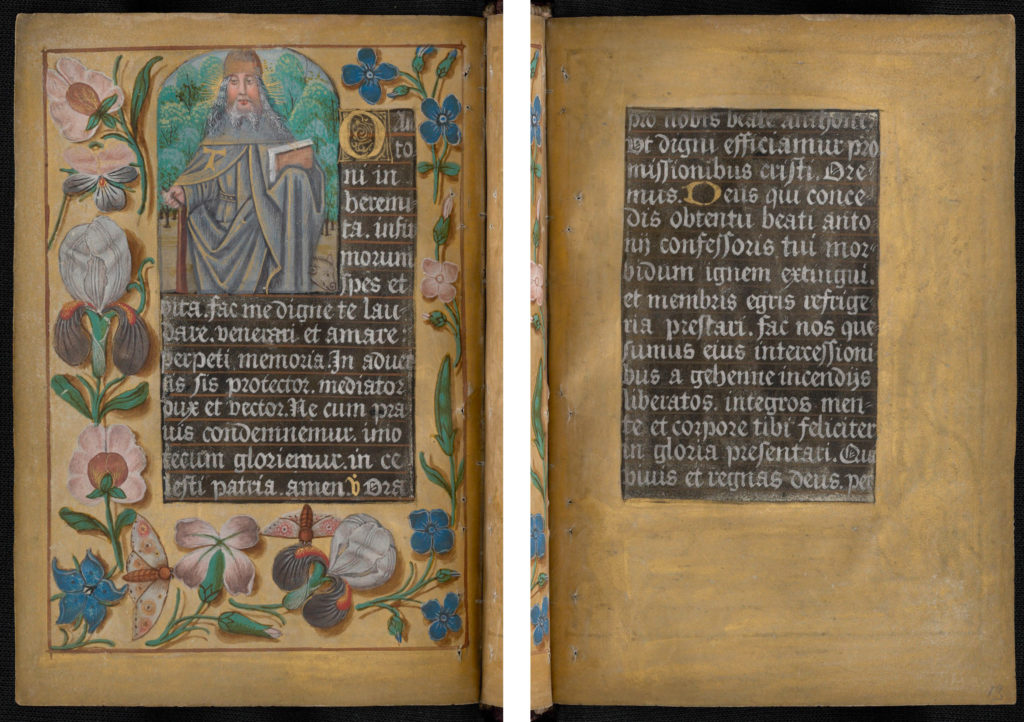
Fig. 11
Organic opening, with a prayer to St. Anthony, Prayer book (Solway 7), KBR, acc. no. Solvay 7 FS IX 7A, fols. 12v‒13r
Masters of the Dark Eyes
Whereas the entirely dyed black manuscripts currently in Vienna and New York were made in the context of courtly Burgundian commissions in the 1450s through 1480s, Solvay 7 represents a much less prestigious commission and was probably made in the first or even the second decade of the sixteenth century. It is in fact unmistakably the product of the Masters of the Dark Eyes, a descriptive name given in the 1980s to a group of illuminators who made manuscripts with stylistic similarities, including painting heavy shadows around figures’ eyes.[14] These painters were active from ca. 1480 to 1520 primarily in Utrecht and South Holland. They worked with a variety of scribes to produce emphatically illuminated manuscripts, some with hundreds of narrative scenes within their folios. Both the painters and the scribes in this group are elusive, considering that we do not know the names of any of them, or even how many different painters worked in this sprawling group, or how they teamed up with scribes. They may have considered themselves a group, since they shared patterns, models, and approach: to lay on paint quickly, thickly, and with saturated colors.
Realizing the large number of manuscripts in this group, Klara H. Broekhuijsen organized them into seven sub-groups.[15] Five of the seven groups, comprising the bulk of Dark Eye manuscripts, can be localized to the province now designated as South Holland (which includes Delft). A sixth group of illuminators produced manuscripts with features associated with the Southern Netherlands (an area roughly equivalent to modern-day Belgium). That is, they are written in Latin in a script called littera hybrida (also known as bâtarde), on folios ruled for large letters. These features contrast with those associated with the Northern Netherlands, where smaller letters written in littera textura (also known as textualis) are usually written on narrower ruling in Latin. Not only do the design features of this sub-group conform to norms associated with the Southern Netherlands, but one of the manuscripts in this group, a choir-psalter, was made in 1521 for a Franciscan church in Limburg.[16] The final group of Dark Eye illuminators moved from the Southern Netherlands to England, where there were more opportunities and fewer competitors; there they completed highly prestigious commissions, including a copy of the Speculum Humanae Salvationis (Mirror of Human Salvation) probably made for King Henry VII (1457–1509) (British Library, London, acc. no. Harley 2838),[17] and a copy of the Ordinances of the Brotherhood of the Immaculate Conception bearing the arms of Henry VII (University of Oxford, acc. no. Christ Church, Ms. 179). Although the Dark Eye painters in England fulfilled highly prestigious commissions, those who stayed in South Holland worked for a clientele who generally lacked coats of arms and were not members of the nobility. One manuscript from Broekhuijsen’s “Southern Group” (Walters Art Museum, Baltimore, acc. no. W.175) does have a coat of arms, as I will discuss below.[18] As I see it, the Dark Eye illuminators gained prestige proportional to the distance they moved from South Holland. Further analysis of Broekhuijsen’s findings would be welcome in this regard. Given the degree to which the anonymous illuminators in the Dark Eyes group traveled, their coupling with scribes in different styles, and their far-flung clientele, it may be impossible to pinpoint where Solvay 7 was made.
Artists who worked in this style, especially those who moved abroad, were responsible for a few exalted commissions, but they largely produced wares for the nouveaux riches of the Netherlands, who valued large, colorful pictorial programs. To fulfill the desires of this audience, these artists primarily painted Books of Hours and image-heavy prayer books. The entire period of activity for this group of artists post-dates the invention of the printing press circa 1440, which suggests that their buyers sought colorful and sumptuous books that a single-color printing process could not generate. Their clientele may have felt sentimental about the recent past, or they may have wanted to climb socially by imitating the tastes of higher-class people from the previous generation. These motivations may have underlain the production of Solvay 7.
Parchment and Script of Solvay 7
Its bright silver and gold script—argyrography and chrysography—distinguishes Solvay 7 from other manuscripts attributed to the Masters of the Dark Eyes, more so than do its images. Given the range of different scripts in the eighty-odd manuscripts attributed to these illuminators, it is obvious that the painters worked with many different scribes. Their painting appears in manuscripts written in small textualis letters by Northern Netherlandish scribes, including convent sisters living in Delft (one of which, now in the Beinecke, will be discussed below),[19] but they also paired their work with scribes who wrote in larger letters on wider ruling typical of the Southern Netherlands, using letterforms derived from those of Burgundian courtly manuscripts.[20] The script in Solvay 7 has some features associated with Burgundian bâtarde, such as a tall, slanted s and f, and a round d whose ascender points backward, but other features associated with the north, such as a two-storey a (a defining feature for textualis).
When designing the manuscript, the scribes must have decided at an early stage to work with silver letters on black, for this decision had implications for every other design decision. The scribe prepared the text block with thick opaque black paint, and then ruled it in gold with lines spaced quite far apart, for only fifteen lines per page. This is relevant, because he (or she) was anticipating the unusual writing technique, where the letters appear not in black ink, but rather in metallic ink: gold-yellow ink for the rubrics, and silver-white ink for the regular texts. The viscosity of the metallic ink (much thicker than regular ink) meant that the scribe had to adjust his technique to form the letters, quite possibly stirring the ink frequently to keep the components in suspension, using a rather wide nib, and forming the strokes more slowly to place the liquid onto the surface with full opaque coverage. The scribe has not planted the letters firmly on the ruling lines, but made them hover about a millimeter above it. The gap between line and letter emphasizes the decorative quality of the ruling by isolating the horizontals, which visually pulsate against the dark background. Overall, the visual effect of the text block is, in a word, showy.
A technical analysis of Solvay 7 will undoubtedly reveal specifics about the parchment and its preparation, the paints, inks, quills, brushes and metallic materials used in the manuscript, but here I offer some preliminary remarks, based on examination with the unaided eye. Usually parchment, which transmits considerable light, provides a luminosity to the page in general. At an extreme, fine parchment with a slightly waxy surface or an oily constitution can be so translucent that it fails to mask the words and images from one side of the membrane to the other. It is not that the ink seeps through the page, but that the marks on one side of the parchment are visible on the other. Sometimes these through-images cause visual confusion and confound legibility (as in Walters Art Museum, Baltimore, acc. no. W.90, fol. 38v).[21] Some manuscript makers dealt with this problem by relegating important images to full-page miniatures, which could be painted on parchment that was blank on the back so that any through-image would not disrupt images or texts on the other side of the membrane. Other illuminators addressed the limitations (and possibilities) of semi-translucent parchment by painting border imagery on one side of the parchment and then tracing it onto the other.[22] Doing so not only saved labor, but the through-images reinforced each other visually, rather than distracting and distorting each other.
Instead of utilizing the translucent property of parchment, scribes and illuminators could negate its translucency in several ways. Most simply, they could choose thicker parchment. In striking a balance between the refinement of thin, fine parchment, and the opacity of thicker parchment, they often opted for thicker material for folios with miniatures and thinner material for the text pages to preserve the suppleness of the book block. The maker of Solvay 7 selected rather thick parchment for all of the folios, perhaps anticipating that it would have to bear the weight of a considerable amount of paint. Secondly, illuminators could combat through-images by ensuring that the parchment effectively diffused the light, by purchasing parchment finished with a velvety surface or an opaque chalky filler. The ultimate way to achieve an opaque page was to paint the parchment with an opaque ground layer.
In Solvay 7, only the text blocks are blackened, which means that the black was applied with a brush rather than with an immersive technique. Therefore, the parchment was not stained with an immersive technique but rather painted by the scribe or illuminator. The centers are black, and the edges gold, resulting in folios thick with the bulky surface material. The final folio of the manuscript has not been blackened (fol. 20v).[23] There are at least two reasons this has occurred. Either the scribe only colored the text blocks that were required (and there is no text on this verso), or else fol. 20 was made in a later campaign of work by someone imitating the technique. The latter would explain why the ruling of fol. 20r is made in a different material, one with a coppery rather than a golden hue, and why the scribe’s vertical strokes (or minims) have less heft. Whether the metallic ink of fol. 20r is the same as the ink used throughout the manuscript is a question that awaits technical verification. The back of the final folio also reveals one of the hazards of metallic script: it has oxidized.
Painting in Solvay 7
Painting with bright white and metallic paints against a black background required painters to rethink how to represent figures, as doing so reverses the regular figure-ground relationship that characterizes most medieval manuscripts.[24] For example, in the Morgan manuscript, the painter portrayed a bush entirely with small strokes of metallic paint and neither delineated the boundary of the form, nor infilled it with color.[25] Isolated from its visual context, one would not know it was presumably a green bush. The viewer sees a dancing array of golden highlights against black-stained parchment. The technique of allowing the substrate color to form part of the palette of the finished work has several relatives. First, in non-dyed parchment manuscripts, illuminators sometimes used the bare parchment to stand for Caucasian skin tone. Second, the reversed figure-ground resembles printing matrices. Third, it is conceptually related to chalk drawings on prepared blue paper (where both black and white lines stand out against the medium-blue all-over color, and the artist can apply both shading and highlights against the blue substrate). Closer to the manuscript context at hand, the technique bears some relationship with manuscript illumination in grisaille (or shades of grey), which likewise employs a limited palette and relies on highlights to represent form. Philip the Good, Duke of Burgundy (1396–1467) and others at the Burgundian court commissioned numerous manuscripts in grisaille from the 1450s onward.[26] New, eye-catching, and unusual techniques of representation often began at courts, where novelty and innovation were in demand.
Whereas the metallic script on prepared parchment in Solvay 7 appears nowhere else in the oeuvre of the Masters of the Dark Eyes, the illumination in Solvay 7—both figurative and non-figurative—has close comparisons with other manuscripts they made. Among the sub-group working in the Southern Netherlands (Broekhuijsen’s “Southern Group”) are two manuscripts related to Solvay 7: Walters Art Museum, Baltimore, acc. no. W.175 (hereafter “W.175”),[27] and Beinecke Library, New Haven, acc. no. Ms. 434 (hereafter “Beinecke 434”).[28] These manuscripts have imagery based on the same models, and some nearly identical border decoration, despite important divergences. They have different scribes and early histories, which are revelatory in terms of the painters’ motivations.
The donors of Walters W.175 are among the few with coats of arms who patronized the Masters of the Dark Eyes. The coats of arms, brandished alongside the couple’s portraits (fig. 12), indicate that they were members of the lower French nobility. Rather than commissioning a private prayer book, they commissioned a Missal, a book type used in a church by a priest or bishop celebrating the Mass. Perhaps they already had a prayer book, or perhaps they wanted to make a donation to a church in such a way that their gift would be acknowledged every time Mass took place. Like many Missals, this one has only one full-page miniature—the Crucifixion prefacing the canon. The patrons did not have themselves portrayed there, but rather at the text for Pentecost, a choice that intimates their affection for this feast. Deploying unusual iconography, the Masters of the Dark Eyes depicted the crowned, resurrected, and blessing Christ to preface this text, rather than the expected image, the Descent of the Holy Spirit. How to explain these choices? The artists have configured this imagery as an epitaph for the couple, as if they were to be blessed by Christ and the Holy Spirit in perpetuity and remembered with particular focus on the feast of Pentecost after their deaths. That the painters did this shows that they were willing to invent creative solutions to meet their customers’ needs, in this case, to be remembered in perpetuity and saved.
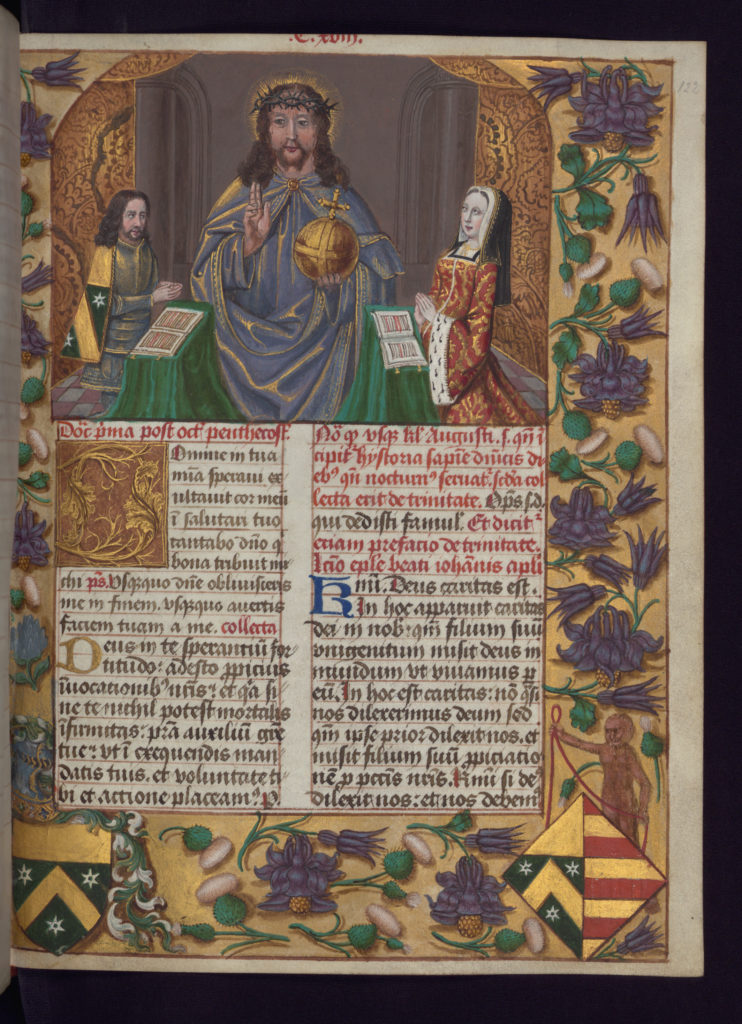
Masters of the Dark Eyes, Christ risen with donors, Missal, Netherlands (Utrecht), late fifteenth‒early sixteenth century, ink and pigments on parchment. The Walters Art Museum, Baltimore, acquired by Henry Walters, by 1931, acc. no. W.175, fol. 122r
Walters W.175 shares common models with Solvay 7 for some of its figurative imagery. Comparing them reveals how the Masters of the Dark Eyes worked from stock model books. For example:
•W.175, fol. 122r (fig. 12) has a two-column-wide miniature depicting the patrons kneeling in prayer on either side of Christ. The central element of that miniature, depicting Christ crowned with thorns, holding an orb, and making the sign of blessing, re-appears in Solvay 7, fol. 4r (fig. 13). Whereas in W.175, the image prefaces the prayers to be read after Pentecost, in Solvay 7 it prefaces a prayer to the name of Christ.
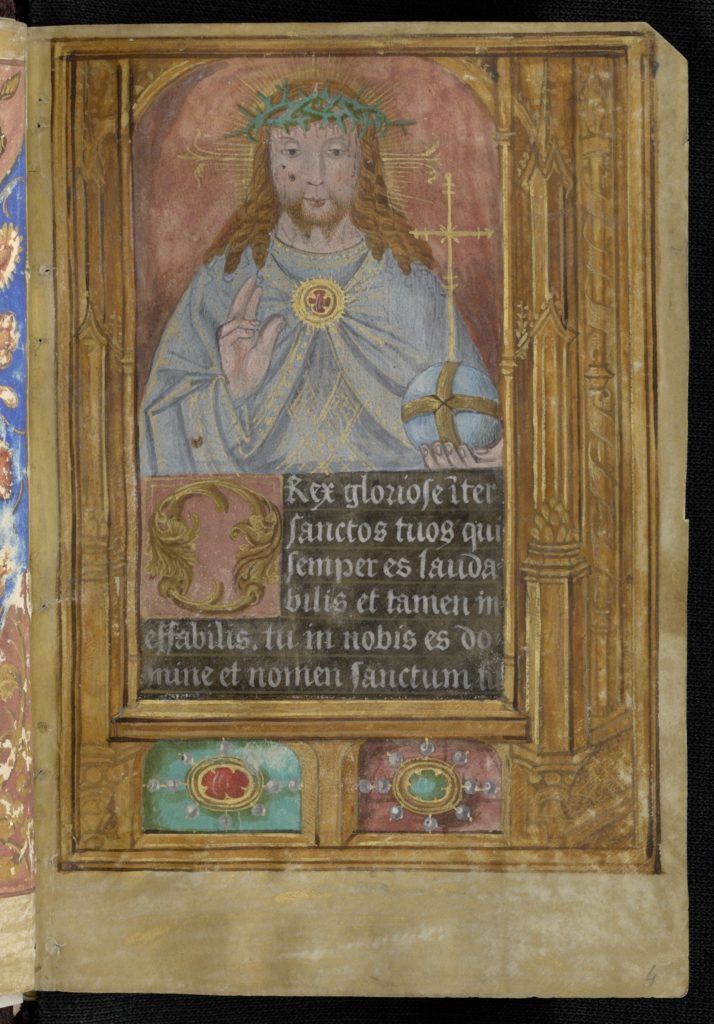
Christ as Salvator Mundi, and a prayer to the name of Christ, Prayer book (Solway 7), KBR, acc. no. Solvay 7 FS IX 7A, fol. 4r
•W.175, fol. 115v has a full-page illumination depicting a crucifixion populated by figures, namely Christ’s family and friends under his right arm, and Roman soldiers under his left. A closely related image appears in Solvay 7, fol. 14v (fig. 14). Both paintings show Mary swooning in the arms of John in similar postures and include a diminutive horse in the foreground, shrunken so that the equine group does not dominate the first picture plane. Both show the rider engaged in intense eye contact with the dying Christ, to indicate that he is Longinus, the Roman soldier who suddenly regained his sight when blood from Christ’s side wound splashed in his eyes. Both images have similar landscape and architectural features in the background. The craftsmanship in Solvay 7 is coarser, and the most notable departure is in the way Mary Magdalene is depicted. In Solvay 7, she bears the snaked coils of hair and plucked forehead that became the standard way of depicting women from antiquity (including sibyls, prophetesses, and early Christian martyrs) in Netherlandish painting around 1490. Whereas the crucifixion image prefaces the canon of the mass (Te igitur…) in the missal, in Solvay 7 the analogous image prefaces a prayer whose rubric indicates that it should be read while looking at an image of the crucifixion. The prayer itself may be the one copied on fols. 15r‒15v, but that is far from certain, since there is at least one folio missing before fol. 15r.

Crucifixion, Prayer book (Solway 7), KBR, acc. no. Solvay 7 FS IX 7A, fol. 14v
•In W.175, fol. 178v, St. Margaret wears a spectacular headdress. The plaited hair, golden threads, and structural elements have been painstakingly worked into a passementerie conglomeration that nearly doubles the size of its wearer’s head. This is matched in volume and elaboration in the headdress of St. Mary Magdalene in the prayer book (fig. 15).
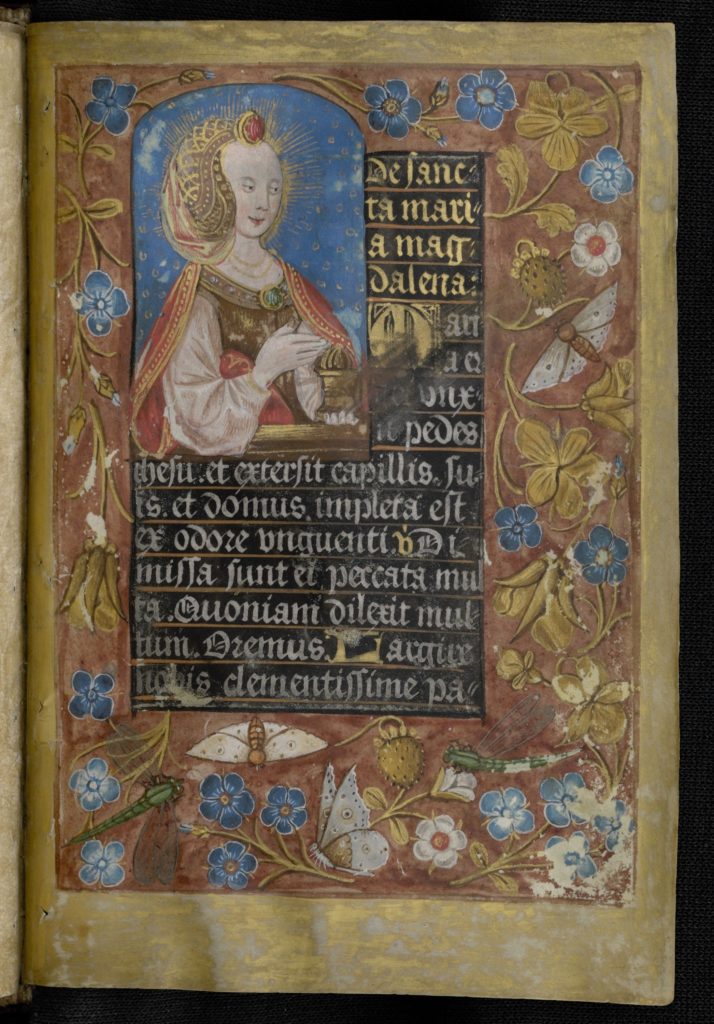
St. Mary Magdalene, Prayer book (Solway 7), KBR, acc. no. Solvay 7 FS IX 7A, fol. 18r
•W.175, fol. 13r has a border with an illusionistic motif of repeating jewels, consisting of gemstones mounted in quadrilobed settings, affixed with tangentially-mounted spokes that each support one or two pearls. These jewels are arranged as if lying on a cloth in a tessellated pattern. The page is bisected vertically and horizontally so that this cloth, in turn, fills alternating quadrants, the others being filled by trompe-l’oeil flowers represented against a gold background. This same distinctive motif appears in Solvay 7, fol. 3r (fig. 4).
The same border motif with the spoked jewels also appears in Beinecke 434, a Book of Hours made in the fourth quarter of the fifteenth century, which the Masters of the Dark Eyes enhanced in the first quarter of the sixteenth. It has a calendar for the county of Utrecht, specifically for the city of Delft. That calendar, plus other codicological features in the manuscript, are consistent with a genesis at the convent of St. Ursula in Delft, a female Franciscan convent that copied manuscripts and embellished them with penwork and painted decoration.[29] That decoration became a problem for the manuscript’s second owner, who wanted to change the style and amount of decoration in the book. Either the owner brought it to the Masters of the Dark Eyes to have it enhanced, or the Masters acquired the lackluster manuscript and used it as a canvas for their creation so that they could add value to it and resell it. They disassembled it, added four full-page miniatures to it, and overpainted the existing border painting of the facing text folios so that it would match the style of the new miniatures. In this endeavor, they worked from stock border motifs: the divided border around Beinecke 434, fols. 56v‒57r (fig. 16) creates compartments for strewn flowers and gems, a motif repeated in both Solvay 7 and Walters W.175. The painters may have chosen this type of border for Beinecke 434 because it begins with an opaque ground, which would have covered the existing border decoration. The Delft decoration—consisting of sprigs and gold balls—immediately adjacent to the historiated initials has been allowed to stand, probably because the rectangular fields of Dark Eye decoration would not have fit neatly against the jagged puzzle initial.

Organic opening, with a full-page miniature depicting angels adoring the Eucharist, facing the incipit to the Hours of the Sacrament, Book of Hours (Use of Utrecht), Netherlands (Utrecht), 1475‒1500, ink and pigment on parchment. Beinecke Library Rare Book and Manuscript Library, Yale University, New Haven, bequest of Gladys Moore Vanderbilt, Countess Laszlo Szecheny, in memory of Cornelius Vanderbilt, 1966, acc. no. MS 434, fols. 55v‒56r
Just as the scribe of Solvay 7 worked with bright script against a black field, the Masters of the Dark Eyes who executed the margins also began with an opaque field. However, they did so in a way indistinguishable from the way in which they executed the borders in other, non-black manuscripts, such as W.175 and Beinecke 434, except in one regard: instead of allowing blank borders around plain text folios (those at the lowest level of the decorative hierarchy), they painted those in Solvay 7 with an extra frame of thick gold. Their understanding of the presumed Burgundian precedents was superficial or flawed. They did not let the black ground seep through the images as the illuminator of the manuscript at the Morgan Library (acc. no. MS M.493) had. The makers of Solvay 7 must have considered their task not to imitate a black-stained manuscript but to make a manuscript for which every square inch was covered in opaque pigment. As with many nouveaux-riches people including those in the twenty-first century, the commissioners had a taste for bling.
Conclusion
While the artists who painted the more famous Southern Netherlandish black Books of Hours demonstrated the idea that figures represented in dark background could be defined as a series of highlights laid on top of a dark background with much of the darkness still visible within the bodies, faces, and clothing, the Masters of the Dark Eyes treated the reversal in a clunkier way. The scribe of Solvay 7 succeeded in producing dramatic silver-white and golden-yellow script on a prepared black background, but the painters were not able to technically master the earlier courtly illuminations. The Dark Eye Masters’ figures on black backgrounds are not qualitatively different from those they executed in their other, uncolored, parchment manuscripts, such as Walters W.175.
While the scribes of Solvay 7 were imitating the look of Burgundian black manuscripts, the illuminators, the Masters of the Dark Eyes, were not experimenting: they made no adjustments to the ways in which they represented figures, light, or radiance. Rather, they deployed the same models and glitzy techniques they used in other non-black manuscripts. The only concession they made to this technique was to continue the gold ground all the way to the edge of the folio.
Perhaps the patron of Solvay 7 already owned a Book of Hours and wanted a supplementary volume that would also showcase his or her avant-garde tastes, with a manuscript bursting with color, metallic calligraphy, figurative imagery, and decoration, including trompe-l’oeil forms. Because the Masters of the Dark Eyes failed to understand the reversed figure-ground concept as well as their scribes did, they created something considerably coarser than their presumed Burgundian model. In the end, they collaborated on a manuscript that required only minimal skill adjustments but resulted in something visually splendid.
Description of Brussels, Royal Library, Solvay FS IX 7A
Manuscript on parchment, 160 x 114 mm, 21 folios (foliated 1–7, 7bis, 8–20)
Made ca. 1510, with 2 full-page paintings and 10 small paintings and illusionistic border decoration by the Masters of the Dark Eyes.
Provenance
Owned by the inventor, doctor, book collector, and perfumier Lucien Graux (1878–1944) as his number 237 (“237” is written in pencil on the inside front cover); sold by his widow through the Gallerie Charpentier, Paris (and listed in the catalogue Bibliothèque du Docteur Lucien-Graux, deuxième partie), 26 January 1957, lot 51; purchased by Madame Louis Solvay (née Odilie Fontaine; 1877–1962; Madame Solvay’s bookplate affixed to the inside front cover); upon her death in 1962, Madame Louis Solvay bequeathed the manuscript, together with her other manuscripts and printed works, to the Bibliothèque royale de Belgique, where the Solvay gift is Fonds Spécial IX. In the Schoenberg database, it is SDBM 16207.
Appendix: Textual Contents, with Structural Notes
Fol. 1r–1v (fig. 3): Prayer to the face of Christ. Incipit: Salve sancta facies… [ends imperfectly]
Fols. 2r–3v (figs. 1, 4): Prayer to the five wounds of Christ, with five small images depicting the fragmented wounds. Incipit: Ave manus dextera Cristi perforata…
Fols. 4r–4v (figs. 13, 5): Prayer to the Name of Christ; with a column-wide miniature depicting Christ as Salvator Mundi. Incipit: O Rex gloriose… [ends imperfectly]
Fols. 5r–5v (figs. 5, 7): Prayer to the Trinity. Incipit: Sancta trinitas unus deus misere nobis… [ends imperfectly]
Fols. 6r–6v (fig. 7): Seven Verses of St. Gregory [continues from fol. 16v, contains the end of verse 6, and finishes with verse 7 and a Jesus-centered version of the Obsecro te] … O domine Jesu Christe, Pastor bone, iustos conserva, peccatores iustifica: omnibus fidelibus miserere, et propitius esto michi misero et indigno peccatori. Amen.
Fols. 7r–7v: Prayer to one’s guardian angel begins in medias res (the first 39 words, in bold below, are on fols. 9r–9v); Sancte angele dei, minister celestis imperii, cui deus omnipotens mei custodiam deputavit: per maiestatem eius et pietatem te humiliter deprecor, ut custodias animam meam et corpus meum: et omnes sensus meos a pravis et illicitis desideriis: a noxiis, vanis, et immundis cogitationibus, et ab illusionibus malignorum spirituum: a pollutione mentis et corporis: et ab insidiis inimicorum meorum visibilium et invisibilium quaerentium animam meam: et sis michi protector tutus, ubicumque iero diebus ac noctibus, horis atque momentis, et conserva me in mundo opere: et confirma me in timore et amore Iesu Christi cum sanctis desideriis: et post hanc miseram et caducam vitam perduc animam meam ad aeternam felicitatem: ubi cum Deo et omnibus sanctis gaudeat sine fine: praestante Domino nostro Iesu Christo: cui est honor et gloria in saeculorum saecula. Amen.
Fols. 7bisr–7bisv: Prayer to the body and blood of Christ begins in medias res. This is a version of a prayer written by Thomas a Kempis, transcribed here: http://www.intratext.com/IXT/ITASA0000/_P66.HTM.
Fols. 8r–9r (fig. 8): Prayers to St. Anne. Prayer in the border begins in medias res (where the underlined words are missing): Gaude felix Anna que concepisti prolem qua fuerat paritura mundi salvatorem Gaude felix Anna mater magne prolis ex te processit rutilans stella sum[m]i solis.
Fols. 9r–9v (fig. 10): Rubric and prayer to one’s guardian angel (for the first 39 words, see above, 7r–7v. Fol. 9v should be followed by fol. 7r), with an 8-line miniature depicting the guardian angel
Fols. 10r–11v (figs. 10, 9): Prayer to the Magi, with a column-wide miniature depicting the three Magi presenting gifts to the Christ Child. Incipit: Rex Iaspar, rex Malchior, rex Balthasar, rogo vos per singula nomina…
Fols. 11v–12r (fig. 9): Prayer to St. Bernard, with an 8-line miniature depicting the Lactation of St. Bernard. Incipit: Caritate vulneratus, castitate dealbatus, verbovitae laureatus, est Bernardus sublimatus… The text around the frame reads Ave, maris stella dei mater al[ma] Monstra te esse matrem, sumat per te p[recem].
Fols. 12r–14r (fig. 11): Prayer to St. Anthony, with miniature depicting St. Anthony brandishing a tau-cross, with his attribute, a pig. Incipit: Anthoni heremita infirmorum spes et vita…
Fol. 14r: Rubric for a prayer to be read before an image of the Crucifixion; full-page miniature (fig. 14), depicting the Crucifixion.
Fols. 15r–15v: Prayer to Jesus attributed to St Bernard, begins in medias res: [mi]serer mei secundum magnam misericordiam tuam. O benigne Iesu … [continues on fol. 17r]
Fols. 16r–16v: Seven-verse version of the Verses of St. Gregory, begins in medias res (where the underlined words are missing): Adoro te domine Iesu Christe in cruce pendentem et coronam, spineam in capite portantem deprecor te domine Iesu Christe ut crux tua liberet me ab angelo percuciente. Amen. Pater noster… Adoro te domine Iesu Christe resurgentem a mortuis et ascendentem ad celos sedentemque ad dexteram… [continues on fol. 6r]
Fols. 17r–17v: [continues from fol. 15v]…vera tua iusticia penam eternam … in omnibus adversitatibus meis patient[am]… [ends imperfectly]
Fols. 18r–18v (fig. 15): Rubric and prayer to Mary Magdalene, with an 8+-line miniature depicting Mary Magdalene with her ointment. Incipit: Maria unxit pedes iesu et extersit capillis capitis sui et domus impleta est ex odore vnguenti…
Fols. 18v–19v: Rubric and prayer to St. Catherine, with a 7+-line miniature depicting St. Catherine with a wheel and a sword. Incipit: Virga sancta Katherina grecie gemma urbe Alexandrina costi regis erat filia…
Fol. 19v: Rubric and prayer to St. Barbara. Incipit: martir gloriosa Barbara quae generosa paradisi vernans rosa castitatis lilium… [fol. 19v ends abruptly; prayer should continue: Ave virgo pulchra tota castitatis fonte tota dulcis mitis et devota vas virtutum omnium ave criminis ignara sponsum…]
Fol. 20r: Prayer to avert sudden death, begins in medias res. Incipit: […]vet ut non subito mortamur…[fol. 20v is blank, unruled, and unpainted]
I am grateful to Marie Hartmann for her useful comments on a draft of this article. The University of St Andrews kindly provided funding for the images. Of the manuscripts mentioned in this article, I have studied Solvay 7; Walters W.175; Lázaro 15656; and Beinecke 434, as well as an example at Columbia University, Plimpton 287, in the flesh but have only studied the others, including the Burgundian black books, from reproductions. Because the photographer at the Royal Library of Belgium shot single folios rather than full openings, the “openings” depicted in this article have been constructed by placing two separate photographs side-by-side.
[1] There are two manuscripts with black parchment in Vienna. The Black Hours of Charles the Bold, Duke of Burgundy, Österreichische Nationalbibliothek,Vienna, acc. no. codex 1856, is the subject of a facsimile with commentary volume; see Ulrike Jenni and Dagmar Thoss, Das schwarze Gebetbuch: Gebetbuch des Galeazzo Maria Sforza: Codex 1856 der Österreichischen Nationalbibliothek in Wien (Frankfurt: Insel Verlag, 1982). Secondly, the Hours of Mary of Burgundy, Österreichische Nationalbibliothek,Vienna, acc. no. codex 1857, has a selection of folios with black text blocks. It has also been the subject of a facsimile with commentary by Eric Inglis; see The Hours of Mary of Burgundy: Codex Vindobonensis 1857 Vienna, Österreichische Nationalbibliothek (London: Harvey Miller, 1995). The manuscript’s bibliography can be found by searching https://www.onb.ac.at/bibliothek/sammlungen/handschriften-und-alte-drucke/bestaende/bestandsrecherche/literatur-zu-handschriften.
[2] Morgan Library & Museum, New York, acc. no. MS M.493 is a Book of Hours for the use of Rome, made in Bruges ca. 1480 and illuminated by someone in the circle of Guillaume Vrelant. This manuscript has also been the subject of a facsimile; see Das Schwarzes Stundenbuch, with a commentary by Bernard Bousmanne and codicological description by William M. Voelkle (Luzern: Faksimile Verlag, 2001).
[3] Despite their visual appeal, the black manuscripts have not been the subject of much scholarly work, outside the facsimile commentary volumes. Exceptions include Bodo Brinkmann, Die flämische Buchmalerei am Ende des Burgunderreichs: Der Meister des Dresdener Gebetbuchs und die Miniaturisten seiner Zeit (Turnhout: Brepols [Ars Nova 1], 1997). Marie Hartmann’s forthcoming dissertation, “Schwarz vor Augen. Die Materialität und Medialität gefärbter Stundenbücher” (Freie Universität Berlin) will be the first sustained synthetic research on the topic.
[4] Hartmann, “Schwarz vor Augen.”
[5] Spectroscopy, for example, would reveal the chemical composition of the “silver” and “gold” inks and show whether they do in fact contain precious metals. For an overview and analysis of the technical methods available to manuscript historians, see Stella Panayotova, ed., The Art & Science of Illuminated Manuscripts: A Handbook (London: Harvey Miller, 2021).
[6] All the items with the collection have shelf numbers beginning “FS IX.” In total she bequeathed nine medieval manuscripts, numbered 1‒9, followed by the letter A, B or C, which indicates the size of the book. Madame Solvay’s bookplate is affixed to the inside front cover of each of the items.
[7] Georges Colin, Marie-Thérèse Lenger, Anne Rouzet, and Franz Schauwers, eds., Bibliothèque de Madame Louis Solvay 1 (Brussels: Bibliothèque royale de Belgique, 1965‒1969), 4, no. 7. Contra this catalogue entry, the manuscript is not a Book of Hours. Other manuscript descriptions in this volume should likewise be treated with skepticism.
[8] After I commissioned photographs of this rather unknown manuscript for this article in 2021, the KBR mounted the images on their website: https://belgica.kbr.be/BELGICA/doc/SYRACUSE/16183863. As of October 10, 2022, the metadata on this website describes the manuscript as a Book of Hours, in my opinion erroneously. As I make clear below, the surviving components do not include any of the texts that define a Book of Hours.
[9] For examples and further bibliography, see Kathryn M. Rudy, Rubrics, Images and Indulgences in Late Medieval Netherlandish Manuscripts (Leiden: Brill, 2017), 60‒67.
[10] Rossell Hope Robbins, “Arma Christi Rolls,” Modern Language Review 34 (1939): 415‒21.
[11] Rudy, Rubrics, Images and Indulgences in Late Medieval Netherlandish Manuscripts, 101‒36 and passim, with further references.
[12] A skeuomorph is a copy of a crafted object made with different, usually cheaper, materials.
[13] Anna Degler und Iris Wenderholm, “Der Wert des Goldes – der Wert der Golde: Eine Einleitung,” Zeitschrift für Kunstgeschichte 79 (2016): 443‒60.
[14] Klara H. Broekhuijsen, The Masters of the Dark Eyes: Late Medieval Manuscript Painting in Holland (Turnhout: Brepols [Ars Nova 10], 2009). See the current author’s review in Quaerendo 43 (2013): 83–93.
[15] Broekhuijsen, The Masters of the Dark Eyes, 272. Broekhuijsen did not know then of the manuscript’s current whereabouts, but she mentioned it was formerly in the collection of Dr. Lucien Graux as a member of the “Southern Group.”
[16] Koninklijke Bibliotheek, The Hague, acc. no. Ms. 78 A 32. See Broekhuijsen, The Masters of the Dark Eyes, 268‒69, cat. 74.
[17] For a digital facsimile and bibliography, see http://www.bl.uk/manuscripts/FullDisplay.aspx?ref=Harley_MS_2838.
[18] For the digital facsimile and bibliography, see https://manuscripts.thewalters.org/viewer.php?id=W.175 .
[19] For example, Fundación Lázaro Galdiano, Madrid, acc. no. MSS I 15656 was probably copied by the sisters at the Franciscan convent of St. Ursula in Delft, ca. 1475‒1500, and then illuminated by the Masters of the Dark Eyes. The book is listed in Broekhuijsen, erroneously as inv. 15959. For a description, images, and updated bibliography, see http://www.bibliotecalazarogaldiano.es/mss/i15656.html.
[20] More work could be done to identify the scribes with whom the Masters of the Dark Eyes worked, but that is beyond the scope of the current paper.
[21] Book of Hours, early fourteenth century, northeast France. For a description and images, see
https://www.thedigitalwalters.org/Data/WaltersManuscripts/html/W90/description.html.
[22] See for example Kathryn Rudy, “Bruegel’s Netherlandish Proverbs and the Borders of a Flemish Book of Hours,” in Jos Biemans, Klaas van der Hoek, Kathryn Rudy, and Ed van der Vlist, eds., Manuscripten en miniaturen: Studies aangeboden aan Anne S. Korteweg bij haar afscheid van de Koninklijke Bibliotheek (Zutphen: Walburg Pers, 2007), 311‒36.
[23] For an image, see https://uurl.kbr.be/1940623.
[24] On metallic script in manuscripts, see Nancy K. Turner, “Surface Effect and Substance: Precious Metals in Illuminated Manuscripts,” in Joseph Salvatore Ackley and Shannon L. Wearing, eds., Illuminating Metalwork: Metal, Object, and Image in Medieval Manuscripts (Berlin: De Gruyter [Sense, Matter, and Medium 4], 2022), 51‒110; Rita Araújo, Paula Nabais, Isabel Pombo Cardoso, Conceição Casanova, Ana Lemos, and Maria J. Melo, “Silver Paints in Medieval Manuscripts: A First Molecular Survey into Their Degradation,” Heritage Science 6, no 8 (2018): 1–13, at 10–13, https://doi.org/10.1186/s40494-018-0172-7.
[25] See the image of the Crucifixion at the opening at the Hours of the Cross, Morgan Library & Museum, New York, acc. no. Ms. M.493, fol. 14v.
[26] Until her book on the topic comes out, see Elizabeth J. Moodey, “Variations on Grisaille in a Newly Acquired Prayerbook (Princeton Ms. 223),” in Colum Hourihane, ed., Manuscripta Illuminata: Approaches to Understanding Medieval & Renaissance Manuscripts (University Park, Pennsylvania State University Press [Index of Christian Art: Occasional Papers 16], 2014), 47‒67.
[27] For a description, see Broekhuijsen, The Masters of the Dark Eyes, 255‒56. For digital images of the complete manuscript, see https://www.thedigitalwalters.org/Data/WaltersManuscripts/html/W175/description.html.
[28] For a description, see https://pre1600ms.beinecke.library.yale.edu/docs/pre1600.ms434.HTM. For digital images of the complete manuscript, see https://collections.library.yale.edu/catalog/10269834. For a discussion of the manuscript’s layered genesis, see Kathryn M. Rudy, Piety in Pieces: How Medieval Readers Customized Their Manuscripts (Cambridge: Open Book Publishers, 2016), 163‒66.
[29] For an overview of the manuscript production at the convent of St Ursula, see Kathryn M. Rudy, “Boston Public Library MS q Med. 86 in the Context of Manuscript Production in Delft,” in Jeffrey F. Hamburger, Lisa Fagin Davis, Anne-Marie Eze, Nancy Netzer, and William P. Stoneman, eds., Beyond Words: New Research on Manuscripts in Boston Collections (Toronto: Pontifical Institute of Mediaeval Studies, 2021), 35‒58.
